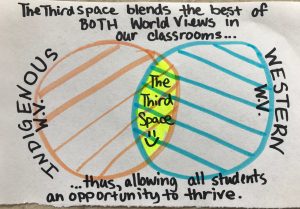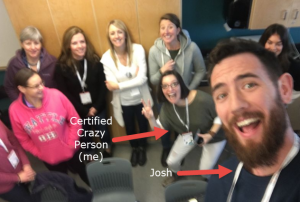I think my name tag sums up the heap of my emotions as I entered the conference location yesterday. People making their name tags beside me were disappointed that only the “negative” emoji stickers were left on the table, whereas I went directly for them. I also got the special “presenter” sticker… placing it upside down was intentional. (“Imposter Syndrome”, perhaps? My inner-bitch can sometimes morph into my inner-coward. Thankfully, I’ve got some great cognitive therapy tricks kicking around my brain from my post-partum days.)
Experienced presenters told me that for them, presenting at a staff meeting was more difficult than at a GAFE conference, but that is most definitely not where I was at. My school is my second home and the people I work with are my second family. When I am surrounded by these wonderful people, I have no issues sharing whatever it is I have to share. If I crap the bed in front of them, they will help me find new sheets. Last week, when I presented at school, I was still very sick and started by saying that I needed to sit down because I was feeling a bit faint. Bryn quickly lept out of his seat to say that he would spot me and so I would land safely should I go down! He literally had my back.
I had a laundry list of worries heading into the GAFE conference:
- Would my technology work?
- Would anyone show up?
- Would the people who did show up, take anything of value away with them?
- Would I be able to overcome my extreme case of nerves so that my witty, fun side would be able to come out?
- Would people get up and leave?
- Would I have enough material?
- Would people participate in the activities I had planned? (Would they roll their eyes?)
- Would I mess up the traditional territory acknowledgement?
- Would I be able to share my newly acquired knowledge from ETEC 521 in an authentic, meaningful way?
My presentation was titled: Collaboration in the Math and Science Classroom: A Blended Approach.
Essentially, I drew on everything I have learned from my entire MET (Masters in Educational Technology) experience. For example, how could I not invite Vygotsky to this presentation??? He is one of the forefathers of collaboration within learning environments! Part of me thinks that a learning theory essay that does not, at the very least, mention him, should automatically be graded lower.
But then, why stop at Vygotsky? Let’s go back even farther in time and acknowledge Indigenous cultures, shall we?
At this very moment, I should be writing my final paper for ETEC 521 where I am searching for ways to create a non-oppressive, academic math classroom that incorporates Indigenous worldviews. I was not sure if 5 people were going to come to my presentation or 55 people, but what I did know, was that everyone who did show, was going to be a high school or middle school math/science teacher. THIS WAS MY CHANCE TO GIVE MY COLLEAGUES AN ALTERNATIVE WORLDVIEW TO CONSIDER. So I went for it!
I began by talking about my own insecurities as a non-Indigenous educator who has been tasked to incorporate Indigenous culture into her lessons. I talked about not wanting to simply exchange the word “boat” for “canoe”, in a couple of word problems. I talked about the importance of making mistakes in front of our students so that they would be less fearful of taking their own risks in front of their peers and teacher. Then, I turned to Dr. Lee Brown’s message. In Dr. Marker’s interview, around the 12 minute, 50 second mark, Dr. Brown talks about the Indigenous learner who has been raised to believe that “together, we are stronger”. That by looking at someone’s work, is not cheating; it is learning. That in Indigenous culture, there are no straight lines; only curves. (Unfortunately, I do not have permission to show this interview on this post. For those readers who are not in ETEC 521, I feel like it is important to share Dr. Brown’s general message somehow. Here is some more information about his passion: emotional health and wellbeing.)
Although I have barely begun my paper, my main conclusion is going to be that by incorporating Indigenous worldviews into our teaching practice, ALL of our learners will benefit, through maintenance of their own emotional health. When we utilize collaborative pedagogies, we are actually utilizing an Indigenous worldview! As Dr. Marker described in our ETEC 521 course, different worldviews can simultaneously be maintained and honoured, whilst also have a space where they overlap, as in a Venn Diagram:

Looking at the sketch I just drew, I honestly think that there is more overlap in our classrooms already. We simply are not labelling and/or being as mindful of the pedagogies that we are doing that celebrate our cross-cultural similarities. Going forward, this must change. We must use better language surrounding Indigenous worldviews and to do that, we must learn more about what these worldviews are. We also must believe in the value of Indigenous worldviews. Honestly, this is the easiest step, as far as I am concerned, as Indigenous worldviews promote interconnectedness, emotional wellness, and the building of one’s identity. Sign. Me. Up!!!
In conveying this message at the GAFE conference, I truly hope that I did the message justice. I won’t ever know for certain, but at least I went for it. I would not have been able to even attempt to share this knowledge had it not been for the ETEC 521.
Once I finished discussing the affordances of a collaborative classroom, my first collaboration activity was the Snowball Fight, which I discovered in a resource that my classmate and Belmont High School teacher, Paul Waterlander shared with me a few weeks ago. If anyone is interested, it is a free, downloadable PDF, “First Peoples Math 8 & 9”. Here is how my first Snowball Fight “went down” last week:
If anyone is interested, I ended up not passing out and/or completely dropping the ball on my presentation due to a few factors.
- I repeatedly told my inner-coward to shut up. It was OK that I didn’t have humorously timed slides or pre-made jokes to tell. It was OK that I wasn’t “Google Certified” and that “Crazy Certified” is also beneficial.
- I gave myself a 1 hour time out. I basically hid and ate free food before my presentation. During that time, I sat by myself and gave the presentation to myself (for the fourth time…).
- I went to my presentation room as soon as the previous presenter was done. I talked to him to see if he had had any tech issues. I shared how nervous I was, and his advice was very comforting.
- I chatted with people as they came in. Introduced myself and asked people to talk about themselves. Some people, I have known for YEARS came in, triggering both happiness and additional anxiety. One teacher came right up to me and introduced himself as Josh Elston, a fellow MET student. We have been in a couple of courses together, as well! That was so great meeting a classmate, face-to-face for the first time!

- Although I stumbled a bit on the acknowledgement, I got it out. It took about 5 minutes for me to relax into the presentation, but what one super nice teacher did, was to go into “teacher mode” and reassure me that this was a safe place and not to worry. I really appreciated her calming words. She was my hero at that point.
In the end, the entire process not only drained me, it challenged me and it then filled me. It really drove home the importance of challenging our students within their Zones of Proximal Development (#VgotskyIsInTheHouse!), as I was in my Zone!
I must thank everyone who came to my presentation, as I would not have made it through without their support, kindness, and willingness to learn about new pedagogies. Thank you to my inner circles who sent me such encouraging words. Thank you to this lady who I have been admiring from afar for years:
It really is unquestionably true: Together we are stronger.


